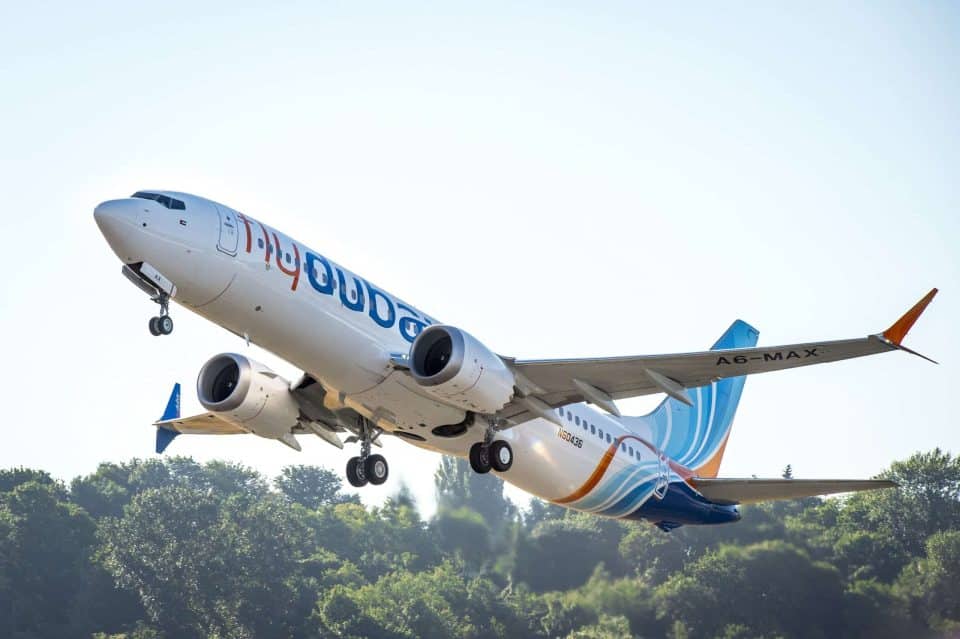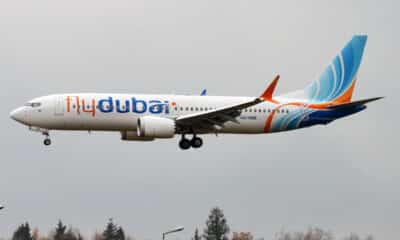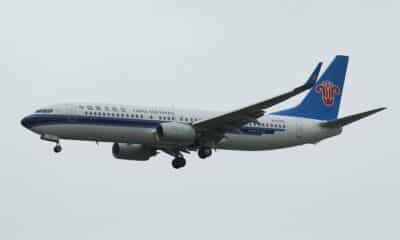Aviation
Flydubai returns the B737 MAX aircraft to passenger service from 08 April

Fly Dubai returns the B737 MAX aircraft to passenger service from 08 April having met all regulatory requirements
Sunday, April 4, 2021 — The Dubai-based airline, flydubai, today announced that its Boeing 737 MAX aircraft will return to passenger service from 08 April. This follows the airline’s compliance with all of the requirements outlined in the Safety Decision issued by its regulator, the General Civil Aviation Authority (GCAA), to ensure the safe return of the aircraft to service.
The first flight to be operated by one of the carrier’s MAX aircraft will be Dubai International (DXB) to Sialkot International Airport (SKT) with the flight currently scheduled to operate on 08 April. The aircraft will operate to other existing flydubai destinations from this date onwards. Passengers will be notified in advance of travel if their itinerary now includes a flight that is scheduled to be operated by a MAX.

Flydubai B737 max interiors Courtesy : flydubai
Commenting on the return of the MAX aircraft to passenger service, Ghaith Al Ghaith, Chief Executive Officer at flydubai, said: “the MAX is integral to flydubai’s fleet and we are confident in the aircraft and its capabilities. I would like to commend the GCAA for their tireless pursuit of air safety and the diligent work undertaken by the flydubai team to ensure the safe return of the MAX aircraft to passenger service.”
Read more : Is China’s COMAC C919 better than B737max and A319neo ?

Flydubai B737 max interiors Courtesy : flydubai
The return to service of the airline’s fleet of Boeing 737 MAX aircraft follows an exhaustive 20-month review which has involved the manufacturer, regulators, engineers, scientists, researchers, mechanics and pilots whose sole objective has been to safely return the aircraft to service. flydubai has met and exceeded the stringent requirements set out by the Federal Aviation Administration (FAA), the European Union Aviation Safety Agency (EASA) and the UAE’s General Civil Aviation Authority (GCAA), which included installing software enhancements, completing a wire separation modification, conducting pilot training and performing thorough aircraft reactivation activities.

Flydubai B737 max interiors Courtesy : flydubai
Commenting on the start of flights, Hamad Obaidalla, Chief Commercial Officer (CCO) at flydubai, said: “we are pleased to see the MAX aircraft rejoin our fleet. While the aircraft’s first flight will be from Dubai to Sialkot, they will operate to a number of flydubai’s destinations over the coming weeks. We look forward to reintroducing our MAX product which includes a spacious lie flat bed in Business Class and an ergonomically designed seat in Economy Class and improved in-flight entertainment with full HD touchscreens.”
Read more : 10 new planes you may fly soon in 2018 – 19
The GCAA has granted the approval for each MAX aircraft to return to service following the fulfillment of the following requirements:
- Software enhancements and additional protections to the Maneuvering Characteristics Augmentation System (MCAS);
- Other software updates not related to the flight control system;
- A wire separation modification;
- A thorough inspection to ensure the aircraft are free of debris;
- Pilot training has been enhanced and includes both classroom and full motion simulator training;
- Conduct operational readiness flights.
For more information about how flydubai is returning its MAX aircraft to service, please go to news.flydubai.com and flydubaiMAX.info.

Aviation
South Korea Introduces Cutting-Edge MRO Center for F-35 and IAI

South Korea is set to make waves in the aerospace industry with the establishment of a cutting-edge Maintenance, Repair, and Overhaul (MRO) hub for F-35 fighter jets and IAI (Israel Aerospace Industries) aircraft.
Central to this initiative is the specialization in converting Boeing 777-ERSF, colloquially known as the “Big Twin,” from passenger to freighter configurations. Under the terms of the agreement, IAI will spearhead the conversion of six B777-300ER and B777-200LR aircraft annually, commencing in 2024. This strategic move is in response to the anticipated surge in demand for wide-body freighter aircraft capable of long-haul flights.
Furthermore, South Korea’s forward-looking vision extends beyond aircraft conversion, with plans to establish a Lockheed Martin F-35 maintenance, repair, and overhaul depot at Cheongju Air Base by 2027. This strategic move not only enhances the operational readiness of South Korea’s air force but also positions the nation as a regional hub for F-35 maintenance expertise.
In preparation for this expansion, thirty Republic of Korea Air Force (ROKAF) engineers and technicians are slated to undergo intensive maintenance training in the United States in 2025, a testament to South Korea’s commitment to fostering local expertise and talent.
IAI’s visionary approach to certification and collaboration underscores the potential for transformative change. With plans for the 777-300ERSF certification process set to unfold in Israel, followed by the rigorous scrutiny of regulatory agencies such as the US Federal Aviation Administration (FAA), the stage is set for the ‘Big Twin’ to soar to new heights of success.
In partnership with esteemed entities like STK and Incheon International Airport Corporation, this collaboration promises to unleash a wave of benefits, amplifying the resilience and competitiveness of the Korean aviation sector while catalyzing job creation and economic prosperity.
Aviation
Lockheed Martin Expresses Interest in Joining AMCA Project

Lockheed Martin, a leading global aerospace and defense company, is demonstrating its dedication to strengthening collaborations with India’s research, industry, and academic sectors. With its rich experience in the aerospace industry and renowned for building some of the world’s most advanced jets, Lockheed Martin is now exploring opportunities to contribute to India’s aerospace sector, potentially providing a significant boost to aerospace technology in the country.
Randy Howard, Vice President of Global Pursuits at Lockheed Martin Aeronautics, recently underscored their interest in exploring “advanced transfer of technology opportunities” with Indian partners, signaling a proactive approach towards fostering technological exchange and advancement in the aerospace domain.
India has been at the forefront of fighter jet development since the 1970s, having produced its own cost-effective fighter jets and combat helicopters, while continually upgrading to maintain competitiveness on a global scale.
Lockheed Martin stands as a dominant force in the aircraft industry, renowned for developing cutting-edge planes like the F35 and F22, some of the most advanced fighter jets globally. They’ve also contributed to projects like the South Korean KF21 aircraft for defense purposes through collaborations.
Now, Lockheed Martin has set its sights on India’s defense sector manufacturing processes, expressing interest in partnering with India on its most anticipated project, the Advanced Medium Combat Aircraft (AMCA), likely to be a 5th generation fighter jet for the Indian military.
Their proposed collaboration could involve a spectrum of advanced technologies, including the Auto Ground Collision Avoidance System (Auto GCAS), a life-saving technology that intervenes to prevent ground collisions, thus significantly enhancing flight safety for Indian pilots.
Lockheed Martin is extending its expertise to design and develop an indigenous cockpit for the F-21 fighter jets, which India is procuring. This collaboration with Tata also includes the development of fighter jet wings. Established in 2023, this partnership adopts a “Ground Floor Design” strategy aimed at equipping India with an in-depth comprehension of 5th-generation cockpit technology and Man-Machine Interface (MMI) systems.
As India’s Fighter jet program advances with finalized aircraft frame and engine prototypes, Lockheed Martin has expressed interest in joining the project. They see a groundbreaking opportunity in cooperative 5th Generation Fighter Development, potentially expediting the AMCA program’s progress through technology and expertise sharing.
Furthermore, Lockheed Martin is keen on collaborating on large-wing, jet-powered UAV platforms, which could enhance India’s unmanned aerial capabilities.
While discussions are ongoing, and specific collaboration details await finalization, this initiative represents a potentially transformative stride in India’s aerospace self-reliance journey and Lockheed Martin’s strategic engagement with the Indian market.
Aviation
Can Airline Seat Cushions Be Used As Life Jackets?

In the event of an aircraft ditching into water, there’s a common question: Can aircraft seats serve as an alternative to life jackets for flotation? The answer lies in understanding their respective functions.
While seat cushions can provide some buoyancy in water, they are not intended nor certified to function as life jackets. Their primary purpose is to offer cushioning for passengers during flight. On the other hand, life jackets are meticulously engineered to keep individuals afloat in water, equipped with buoyancy materials, secure straps, and reflective elements for visibility. They offer numerous advantages over mere cushions.
While a seat cushion might offer temporary assistance in staying afloat, it’s not a dependable substitute for a proper life jacket during an emergency. It’s crucial to utilize approved safety equipment when near bodies of water. A life jacket, designed to keep a person buoyant for extended periods, offers the rigidity needed for prolonged flotation and allows for easy movement of the arms to navigate effectively.
What fabric is used in aircraft seats?
Seats are meticulously designed to fulfill multiple purposes, ensuring passenger comfort, safety, and protection from unforeseen circumstances like fires and accidents. A typical design incorporates an aluminum frame with blocks of polyurethane foam affixed to it. Additionally, a layer of fire-resistant fabric, such as Kevlar or Nomex, is often applied over this framework, topped with a layer of cloth or leather.
Leather seats, while luxurious, are more expensive compared to traditional cloth seats. The majority of fabrics used in seat upholstery contain at least 90% wool fiber, with the remainder typically consisting of polyamide (nylon). Wool stands out as the primary fiber chosen for commercial airline seating fabric due to its desirable properties and suitability for such applications.
What is the lightest economy seat?
In recent times, airlines have been downsizing seat dimensions to accommodate more passengers, resulting in reduced cushion length and leg space. This contrasts with earlier times when airlines offered more generously cushioned seats and ample amenities.
According to Recaro Seats Company, their SL3710 model represents the lightest economy class seat available, weighing in at a mere 8 kg (17.6 lb.), setting a new standard in aircraft seating.
For individuals weighing more than 350 pounds, fitting into a standard economy-class seat can be a challenge due to the narrower dimensions. Economy seats, also referred to as “coach,” “standard,” or “main cabin” seats, typically range from about 40 to 48 centimeters in width, further emphasizing the need for more accommodating seating options.

























